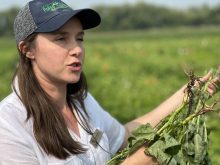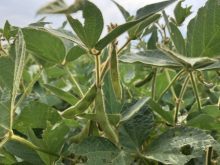Ask a couple of Saskatchewan organic farmers how their harvest went and you’ll get starkly contrasting answers depending on where they live.
A jagged line stretching from Meadow Lake through Moose Jaw to Ogema demarcates where conditions went from good to bad, with crops on the west side faring far better than those on the east.
Abundant moisture led to one of the best harvests in memory for growers in the southwest, while frost spoiled what was shaping up to be equally dandy crops in the northeastern corner of a province that accounts for more than 70 percent of prairie organic production.
Read Also

Fusarium head blight mycotoxin detector in the works
A PhD student at the University of Saskatchewan has been working on developing a method of detecting fusarium damaged kernels to ease the struggles of producers, agronomists and industry.
Kirby McCuaig was one of the lucky ones in a year of haves and have-nots. He is nearing the end of harvest on his Nature’s Acres Organic Farm in Eastend, Sask.
“It looks real good,” said McCuaig.
A few fields of spring wheat and durum suffered hail damage but aside from that he is pleased with the yield and quality of his crops.
More than 600 kilometres away, near Tisdale, Sask., it has been a disheartening fall for Norm Bromm.
“It’s pretty depressing, that’s for sure. When you don’t have any product to sell you’re in pretty rough shape.”
Bromm said he’ll be lucky to get 10 bushels an acre out of a crop of flax that was destined to yield four times that amount. Despite “creeping along” with the combine, little of the seed ended up in the tank.
His wheat may yield slightly better, but the crop is frozen and will be sold into feed markets. There is no seed in his red clover and alfalfa fields and what was shaping up to be a 130 bu. oat crop had to be plowed under.
“We worked it down and it was as green as grass yet. It would have needed another month,” said Bromm, who didn’t take out insurance on his crops.
Glen Neufeld, president of Sunrise Foods International Inc. and marketing manager of Marysburg Organic Producers Inc., said processors will spend a lot of time and effort this fall trying to rescue much of the province’s estimated 750,000 acres of organic crops.
The hard red spring wheat was particularly hit by the frost. But the crop might not be a total writeoff.
“What we’re trying to do is see if we can salvage some of the feed wheat by sizing it, trying to make milling wheat out of it if the buyers will accept it.”
Using a sieve to isolate the larger wheat kernels in samples of frozen feed wheat, Neufeld was able to obtain acceptable falling numbers.
“We just got the test results back today and they weren’t even too bad.”
He intends to ship the sized samples off to international millers to see if they can work with the frost-damaged crop.
Lentils, malting barley and flax are three other crops that didn’t fare well. Much of the flax is unsuitable for crushing or food markets.
“My guess is the flax price is going to go up,” said Neufeld.
It wasn’t a total wreck for farmers in frost-affected regions. There appears to be decent pea and CPS white wheat crops, and oats, an organic mainstay for many growers, fared better than others. Neufeld also pointed out that even with his much-reduced yields, Bromm could realize $250 an acre on his flax crop.
That is small consolation for Bromm, who was expecting a lot more before the frost hit.
“It was a beautiful crop,” he lamented.















